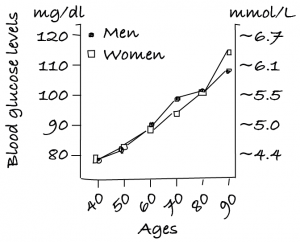Your blood glucose (BG) levels rise when you eat a meal. Your body naturally responds to this, regulating BG levels by releasing insulin, which signals to various tissues in your body to absorb this extra glucose and return your BG levels to normal. How well your body is able to do this is dependent in large part on how sensitive it is to the insulin. If it’s a bit ‘insulin resistant,’ then it will take longer for your BG levels to return to normal after a meal, or it can even remain always a bit high (such as with diabetes).
The main reason you wouldn’t want high BG levels in general is that fasted BG levels are associated to increased mortality rates – the higher they are, the worse off you are1,2. Unfortunately, aging makes your fasted BG levels slowly rise (see below)1, and it rises less fast in people who end up living longer2. Not only that, but for any given age you have, having BG levels higher than average is also associated to even looking older3! In a study with 602 adults looking at facial images, per 1 mmol/L increase of blood glucose levels, perceived age of an individual increased by 0.40 years on average, already accounting for the age differences that naturally occurs3.

Above is a graph adapted from Yashin et al. 20091, a study based on the Framingham heart study data, showing how blood glucose levels steadily increase during aging. Note, 80 mg/dl (the BG units used in the US) is about 4.4 mmol/L (the BG units used in Europe). If having lower BG levels is associated to living longer and having higher BG levels is associated to higher death rates and looking older, it’s not so far off to say that higher blood glucose levels can speed up your rate of aging. Indeed, studies in mice often find the same thing, namely, that interventions that extend lifespan also make the mice more sensitive to insulin and they have lower BG levels4.
The bottom line: it makes complete sense to try to manage your meals so that your blood sugar levels stay within a healthy range, without spikes, and that you don’t constantly push your body to extremes releasing high levels of insulin. You can do this just by checking your body’s glucose response to foods and choosing foods that stay in a healthy range5–7.
.
